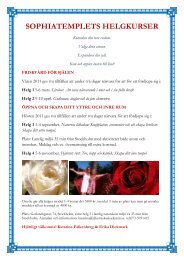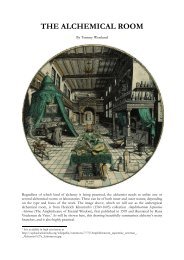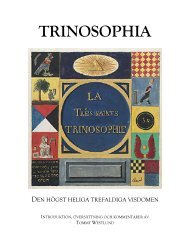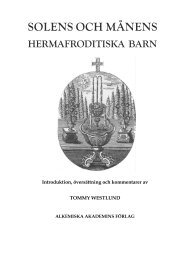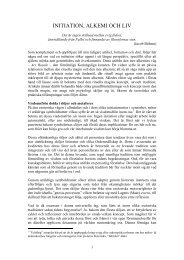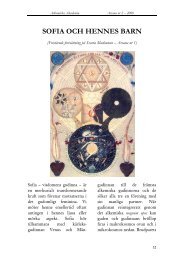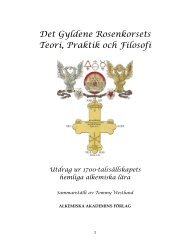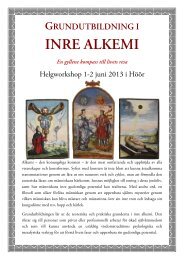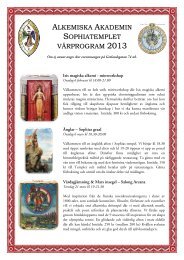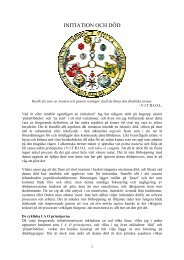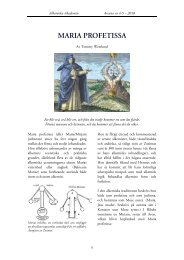Initiation, Alchemy and Life - Alkemiska Akademin
Initiation, Alchemy and Life - Alkemiska Akademin
Initiation, Alchemy and Life - Alkemiska Akademin
Create successful ePaper yourself
Turn your PDF publications into a flip-book with our unique Google optimized e-Paper software.
INITIATION, ALCHEMY AND LIFEBy Tommy WestlundThere is no difference between eternal birth,restoration from the Fall <strong>and</strong> the finding of the stone of the philosophers.(Jacob Boehme)As a complement <strong>and</strong> sequel to my earlier article, <strong>Initiation</strong> <strong>and</strong> Death, the present textconcerns aspects of what an initiation seeks to accomplish in a longer perspective,specifically after the dark night of the soul has been experienced <strong>and</strong> overcome. This isthe basis of the path of inner alchemy – Ars Royale – the profound Royal Art. A furtherpurpose is to show the relation between ritual magic <strong>and</strong> inner alchemy; so to speakpaints a bigger picture of the nature <strong>and</strong> first end of the work, where ritual magic acts as apractical gateway into the profound mysteries of alchemy. Thus this article is writtenprimarily for people already possessing some knowledge of the concepts of ritual magic,regardless of tradition. Also, the article aims at discussing different foundations <strong>and</strong>concepts of ritual magic, where magic <strong>and</strong> psychology differ, as well as the theoretical <strong>and</strong>practical applications that follow from that.Seeds of wisdom in veils <strong>and</strong> metaphorsOn the esoteric path in general, <strong>and</strong> its different rites of initiation in particular, we meetancient dramas of symbolism whose purpose is to sow seeds of wisdom within us. 1 It is1The term “ancient” here alludes to that they are built up around eternal or archetypical patterns of howthe micro- & macrocosm work <strong>and</strong> interact, not on their historical, “real” age.1
worth stressing that these seeds of wisdom are sown within us. No initiation, or magicalwork, does this automatically, or even necessitates an increase in wisdom. It is when wefirst manage to penetrate behind the veils of the symbols <strong>and</strong> underst<strong>and</strong> theirimplications for us here <strong>and</strong> now that the seed can begin to grow <strong>and</strong> our inherentwisdom can start to blossom.These inevitable veils <strong>and</strong> the manner of presenting them also tend to be, what to a greatextent, distinguish literature <strong>and</strong> separate different Orders. In this regard the quality oftheir teaching <strong>and</strong> work depends upon a living tradition that has been integrated <strong>and</strong> to acertain extent also personified by the person or persons that aim at mediating thedoctrines. It is this living, <strong>and</strong> as a rule oral tradition that renders possible the mediationof wisdom <strong>and</strong> underst<strong>and</strong>ing beyond the limitations of words. Words, to be able to becarriers of knowledge, need to be expressed from a personal underst<strong>and</strong>ing. The sensebehind them, which is thus mediated through a living tradition, carries more keys withinitself than is ever possible to describe in words.Thus the adepts throughout history seek to instruct their successors by ancient dramas ofsymbolism <strong>and</strong> light up the paths that lead from the darkness of ignorance to the divinelight. The difference between these rites <strong>and</strong> their exoteric equivalences is the individual“gnosis-process” which concerns itself with the essence of the Law (Maat), instead offaithfully following, applying or wrongly interpreting its outer reflection.What then is the essence of this universal law, which has been taught within variousesoteric traditions since the beginning of time? Well, behind the first veil, to see theimportance of cycles <strong>and</strong> reflections <strong>and</strong> the significance of cause <strong>and</strong> effect concepts. Asmagicians we learn how to read, interpret <strong>and</strong> affect these, foremost within our ownsphere of sensation <strong>and</strong> then being able to apply the same upon the world around us.This ability can concisely be said to summarize the modern underst<strong>and</strong>ing of magic <strong>and</strong>alchemy, which then are reduced to a holistic existential developmental psychology withan occult key signature. The magical <strong>and</strong> alchemical practices then contribute to what thefamous psychologist C.G. Jung termed the individuation process, which also Jungconsidered that the alchemists, foremost unconsciously, had strived for throughouthistory. All alchemical theories <strong>and</strong> axioms were thus interpreted by him to just concernpsychological processes, which perhaps was a necessary antithesis to the long lived beliefthat alchemy was just an attempt at physically transmuting non-precious metals intogold.In my opinion this psychological interpretation, just as the tenacious gold makinginterpretation, neither gives a correct image of the work towards Magnum Opus (theGreat Work) nor takes into consideration the light <strong>and</strong> wisdom that the adepts have triedto spread around the same.The adepts, however, have always used codes <strong>and</strong> symbols that are hard to penetrate,both for preserving the purity in their wisdom <strong>and</strong> for erecting smoke screens in front ofthe eyes of the profane. The purpose in both cases was, <strong>and</strong> still is, that only those who2
can see, i.e. have experienced gnosis <strong>and</strong> underst<strong>and</strong>ing, haveawakened their inner wisdom, will be able to grasp the essenceof the tradition. Hence they have not been too much concernedabout existing misunderst<strong>and</strong>ings about the nature <strong>and</strong> aim ofthe work. And even though it is my intention here to displaythe essence of Magnum Opus in clear words, this article willstill leave intact many of the mysterious veils. Thus by necessity,not only because of this author’s own lacking, <strong>and</strong>shortcomings, but also because the mysteries have alwaysdem<strong>and</strong>ed silence as one of the most important principles forbeing able to progress on the path. In silence the seed ofwisdom can grow, the unconscious can work on the symbolism,<strong>and</strong> the knowledge can be understood <strong>and</strong> transmuted intowisdom.The essence of Magnum OpusThe Great Work is about to create the mythical Stone of the Wise. What then is thisstone? Well, nothing less than the means to immortality! This immortality, or eternal life,should however not be misunderstood. It does not mean that the body will never die -something that would be against the cycles <strong>and</strong> laws of nature. The alchemists havealways maintained that their work is in harmony with nature <strong>and</strong> that they begin wherenature ends, since some processes cannot be reconstructed without the help of nature. Byeternal life is meant instead that consciousness remains after the death of the physicalbody <strong>and</strong> preserves into the next incarnation, <strong>and</strong> the following. This then is what thestone, which isn’t a stone contains, the immortal consciousness of the adept.Perhaps the most comical is that the adepts have always spoken in clear words regardingthis, but despite this, only a few have understood its meaning. So to eliminate eventualmisunderst<strong>and</strong>ings it is worth repeating; Magnum Opus leads to eternal life, not in thesame body but the ability to move <strong>and</strong> transcend consciousness after the death of thephysical body - an eternal birth that does not involve a “fall of consciousness”.Consciousness <strong>and</strong> deathThis leads us unsought to one of the most misunderstood existential concepts; whathappens with our consciousness, our self, after the physical death. In modern times,foremost the spiritualist movement <strong>and</strong> its branches have put forth the idea that anyonecan remember earlier lives (<strong>and</strong> thus preserve consciousness after death), which in theeyes of the adepts is a somewhat naïve opinion. There are today plenty of courses, groups<strong>and</strong> therapists that feather their own nests on peoples need to be seen, to at least havebeen an important person once somewhere in a previous life. The majority of these socalled“memories” derives from the individual <strong>and</strong>/or collective unconscious. Thepsychological research of the last century clearly shows how the symbols of theunconscious arise <strong>and</strong> come forth either as a confirmation of psychological needs or as acontrast or antithesis to conscious opinions. The interpretation that it has to do withmemories from previous lives can in best cases be accurate from the hypothesis that one3
can “tune” into archetypical memories, which partly could explain the multitude ofpeople remembering incarnations as Cleopatra, Ramses II, Caesar, Napoleon, etc.Personally, however, I consider the majority of such cases as originating from the astral<strong>and</strong> illusional dimensions of Yesod. In any case it is an abyss of difference between this<strong>and</strong> what the adepts alludes to.In ancient Egypt, this ability was described by a sun with two wings - the sun, symbol ofthe self (consciousness) together with a pair of wings, the ability to travel between theworlds. This was the symbol of the winged Horus, which the Pharaoh would betransmuted to after his or her embalming process (in the identification with Osiris), tothereafter be able to regain the lawful place amongst the gods <strong>and</strong> goddesses.The Egyptian rites sought to prepare the c<strong>and</strong>idate (most often the Pharaoh or closerelative to him/her) for all the trials that the soul was believed to face after death. Aboveall in the later rites (starting with ‘the book of coming forth by day’ – more commonlyknown as ‘the book of the dead’) these journeys <strong>and</strong> trials took place in Amenti, theEgyptian death realm where Osiris ruled. In the earlier rites, from the first dynasties, thejourneys <strong>and</strong> trials took place in the sky. 2A concept, which is present already in the early Egyptian descriptions of “life after death”,is the importance of underst<strong>and</strong>ing that one has actually died, <strong>and</strong> then to have thecapacity for an individual consciousness after death. This can be compared with theability for lucid dreaming, where the dreamer is fully conscious that what is experiencedis a dream <strong>and</strong> at the same time retain individual memories <strong>and</strong> experiences. Deathresembles falling asleep where the conscious slowly ebbs out into various heavens or hells,for them loosening all aspects of individual memories <strong>and</strong> experiences.From this one might think that the ability of lucid dreaming constitutes the key thatopens up the portals between the worlds (both before <strong>and</strong> after death), but that is not thecase. Lucid dreams, as astral travels, generally take place within the seven palaces ofAssiah 3 , located within the treacherous astral-illusional mists of Yesod. Further, the “astral2In both the first pyramid texts from the 5 th dynasty (around 2500 BC) <strong>and</strong> the later coffin texts from the11 th dynasty (around 2000 BC) the journey started in the east to follow the course of the Sun over the sky.From the 18 th dynasty <strong>and</strong> the new kingdom the journeys <strong>and</strong> trials took place in Duat in the netherworld.The significance of this topic will be explained in an upcoming article.3The Nephesch, the astral body, is divided into its seven Palaces, combining the Sephirotic influences intheir most material forms. That is, the world of passions dominated by the Ruach, or by the world that isbeyond. That is, its Sephiroth are passionate, expressing a passionate dominion. Thus, its three SupernalSephiroth, Kether, Chokmah <strong>and</strong> Binah, are united in a sense of feeling <strong>and</strong> comprehending impressions.Its Chesed is expressed by laxity of action. Its Geburah by violence of action. Its Tiphareth is expressed bymore or less sensual contemplation of beauty, <strong>and</strong> love of vital sensation. Its Hod <strong>and</strong> Netzach, by physical4
ody” is connected with the physical body <strong>and</strong> requires a great amount of energy fromthe same to allow consciousness to be separated from the body for a longer period oftime. This is often symbolically described as a silver cord combining the two bodies, <strong>and</strong>everyone who has had an out-of-body-experience know the kind of difficulties that soonarises in regards to the capacity to regain a focused consciousness.The astral body, or body of light (the Kabbalistic Nephesch) was viewed by the Kabbalistsas being the “true” body, of which the physical body is but a reflection. It is the bonds ofthis etheric body with the various urges in the seven palaces of Assiah that the esoterictraditions have sought to clarify <strong>and</strong> work with. For it is first when the urges can becontrolled that the adept truly can be called a free human, no longer governed byunconscious impulses <strong>and</strong> influences. This is a very simple description of the esotericmeaning of the fall <strong>and</strong> the restoration there from.Within certain traditions complete asceticisism has been promoted, while others havegone to the opposite end <strong>and</strong> promoted indulgence within all palaces <strong>and</strong> urges so thatthey thereby can lose their grip. Many of the modern esoteric traditions teach methods ofhow to know these aspects of oneself (i.e. to make them conscious) so that one no longeris ruled by them, although there still are many moral values that make this difficult. Thisaspect of liberation strongly resembles Jung’s individuation process, from which theredoes not exist any real difference between magical <strong>and</strong> psychological work. However,what distinguishes the magical alchemy from psychology is that this work takes place forthe purpose of being able to create a new body, which is more spiritual than the physicalbody but more physical (i.e. constant) than the astral body. This is one of the esotericmeanings of the three alchemical principles, Sulphur F, Mercury H <strong>and</strong> Salt G, whichshall be separated, purified <strong>and</strong> recombined. First then can the Stone of the Wise beproduced; the spiritual body that can travel between the worlds, <strong>and</strong> which is notdependent upon the physical body.Thus the alchemical-magical process does not seek to escape neither from the earth norfrom the body, but to refine the latter <strong>and</strong> thereby, with the assistance of its energies,form the stone. A very simplified description of this process follows.Prima MateriaNo alchemical work can start or take place without the alchemist being fully aware ofwhat its prima materia, its original material, is. However, this is a subject that hasperplexed aspirants throughout the centuries, since all alchemists has described primamateria in symbolic terms which often seems to resemble zen koans than anythingunderst<strong>and</strong>able <strong>and</strong> concrete. From alchemical classical works we can read that materiaprima is lead, the dragon, urine, dew, the water of life, cinnabar, the eagle stone, thepoison, the virgin milk, chaos, honey, gold, silver, etc.wellbeing <strong>and</strong> health. Its Yesod is expressed, by physical desires <strong>and</strong> gratifications. Malkuth, by absoluteincrease <strong>and</strong> domination of matter in the material body.5
To make the underst<strong>and</strong>ing of prima materia easier, it should help to know what thealchemist aims at extracting from there, namely the philosophic or inner Salt G. ThisSalt, also called VITRIOL, contains the two other principles, Mercury H <strong>and</strong> Sulphur F. Bysoftening <strong>and</strong> extracting the water element from the earthly darkness, the spirit ofMercury is extracted which is variously called the white lily, the eagle or the dragon. It isfrom this that the art around the Stone of the Wise is based <strong>and</strong> founded, as it containsthe volatile fire, the philosophical Sulphur – the most pure ingredient of the Stone of thePhilosophers.The truth is that both prima materia <strong>and</strong> its stone depend upon the purpose of thealchemical operation. If one aims at producing an elixir, its prima materia can be aspecific plant or mineral, where one so to speak takes the prima materia that nature itselfhas produced <strong>and</strong> developed as far as possible, <strong>and</strong> then “refines” it. As the purpose withthis article is the concept of eternal life, we will not need to look for our prima materiawithin the plant or mineral kingdoms. In inner alchemy, Ars Royale or the Royal Art,there is only one conceivable prima materia, the Temple of our Spirit. 4 (This, however,has not stopped alchemists from, in laboratory environment, using everything from bodysecretion to excrements as prima materia, with no other result than blood, sweat <strong>and</strong>tears.) The work starts with the physical body, which is the first key of the work. In themagical work this means the necessity to ground every experience <strong>and</strong> insight in thephysical body. In inner alchemy the Athanor of the alchemists is the physical body.The alchemists have thereafter in broad outlines divided the process into three stages,nigredo, albedo <strong>and</strong> rubedo. In each phase takes place the works of separating, purifying<strong>and</strong> recombining the three principles of Salt, Sulphur <strong>and</strong> Mercury; our body, soul <strong>and</strong>spirit.Alchemical principle Entity Effect NatureG Salt Body Combining FixedF Sulphur Soul Burning MutableH Mercury Spirit Dissolving VolatileNigredoThis stage has been more thoroughly discussed in the article <strong>Initiation</strong> <strong>and</strong> Death (with amagical-psychological emphasis). In a concise way, it is the art of dissolving theillusionary self into its smallest elements <strong>and</strong> facing the dark night of the soul. It is theblack phase where the roots of the Nephesch with the seven palaces of Assiah shall beliberated, so that consciousness <strong>and</strong> will can be centered in the Ruach (approximateequivalent to the self in psychology). The focus is to separate G from HF, so that thespirit can burn the G into a white ash, its essence, <strong>and</strong> extract its soul from the same.In Egyptian mythology, this phase can be compared with the journey of the dead soulthrough Amenti, the death realm, where perils constantly threaten to terminate the4The reader is here asked to meditate upon what that term actually implies.6
journey before the goal has been reached. This archetypical journey is the same as theSun, Ra, was considered to do each night, <strong>and</strong> it was far from obvious that the journeywould have a happy ending. The dead soul has to endure many trials before finallyentering into the Hall of Maat <strong>and</strong> there meet Osiris, the ruler of the netherworld. If theheart of the deceased managed to balance the feather of Maat, truth, i.e. if the person hadlived a life in accordance with Maat, the journey could continue.From an initiatory perspective, the c<strong>and</strong>idate has met <strong>and</strong> liberated the bonds of theNephesch from the seven palaces of Assiah, <strong>and</strong> regained the true inner throne as a Kingor Queen. Videlicet, received the ability to consciously rule oneself instead of being ruledby inner <strong>and</strong> outer influences <strong>and</strong> circumstances. The basic condition for this is that theshadow or the dweller at the threshold has been met <strong>and</strong> overcome/integrated. Interestingto note here is that this is very clearly depicted in the Egyptian traditions. The god Sethhad long since been identified with darkness, destructibility <strong>and</strong> chaos. However, in thepicture beneath, it is Seth <strong>and</strong> Horus who together crown the pharaoh 5 - Light <strong>and</strong>darkness in perfect harmony.5Seth was originally a greatly valued god <strong>and</strong> the only entity that could face the gaze of the chaos snakeApepi without being paralyzed, <strong>and</strong> he was thus a natural <strong>and</strong> esteemed participant on the bark of Ra. Itwas first during the later dynasties that he became associated with evil <strong>and</strong> chaos. The picture shows howSeth <strong>and</strong> Horus jointly crown the Pharaoh Seti I from the 19 th dynasty (around 1300 BC).7
This process is often described in moral terms in the classical books, but can also be seenfrom another perspective. All the complexes <strong>and</strong> urges that we unconsciously carry withinus cost an enormous amount of energy to sustain. Instead of doing what we really intendto do, we build castles in the air with different scenarios about what could happen, whatshould have been said, how our environment will react if we do a, how we will react if thesame says b, what the person really meant when saying c, etc, etc. All this energy not onlyattaches us with the seven palaces, it is also greatly needed for the upcoming work.AlbedoAlbedo is the white phase, which allows the influx from the Ruach into the sphere ofsensation (Ruach as the reflection of Neschamah – the inherent divinity of mankind). 6This phase is in most cases filled with energy, power <strong>and</strong> insights that continuously wantto manifest. H <strong>and</strong> F shall here be separated, which is done by the burned G from theprevious phase. The moist shall be made dry, <strong>and</strong> the dry shall be made moist. The bodyshall be changed into a soul by the power of the spirit, <strong>and</strong> the soul shall be transformedinto a spirit.The new body of light or diamond body is created in the albedo phase, but it is still notconstant, i.e. it is possible to use <strong>and</strong> work with it but the work is far from completed.The dead soul has identified itself with Osiris <strong>and</strong> reached contact with its holy guardianangel. The burned white ash from the previous phase is put as a shelter around the body,which without exaggeration can be viewed as a mummification. In the contact with theguardian angel, the prerequisite for the next phase is created. The cut up Osiris meets hisspouse Isis, <strong>and</strong> by her magic the new body is created, personified by their child Horus. Itis very significant that Osiris, according to the myth, was cut up in 14 pieces (the doubleaspects of the planets <strong>and</strong> the seven active <strong>and</strong> passive phases of the work), which Isis hadto travel over the Nile (the river of <strong>Life</strong>) to find, one after the other. However, she onlymanaged to find 13 but received assistance from Thoth (Logos) to recreate the last piece,the phallus of Osiris. In alchemical literature this is described as, without the divine aidthe first stone will never be found or created, regardless of how much the alchemist tries.6Or rather it means that the sphere of sensation exp<strong>and</strong>s to encompass the Ruach.8
Gentle said this phase involves a paradigm shift for the aspirant, both in regards thedesign of the personal work <strong>and</strong> the underst<strong>and</strong>ing of the process as a whole. A formerluna " consciousness here starts to manifest as a solar ! consciousness. It is againnecessary to identify <strong>and</strong> resolve bound up energies, however not in the same manner asearlier since the focus is another body.Some words need to be said about the colours of these two phases, black <strong>and</strong> white. Eventhough these are in an opposite relationship with each other, <strong>and</strong> black for many peoplehas a more negative tone than white, they have a much more profound meaning inalchemy. The first black phase in no way needs to be experienced as “black” according tothe common present definition. On the contrary, it is generally speaking experienced as alife giving <strong>and</strong> exp<strong>and</strong>ing phase. To again allude to the Egyptian mysteries, the colourblack represented life since the yearly flooding of the Nile left a wide black zone of slagbehind, with the result that the desert bloomed <strong>and</strong> the earth fertilized. Likewise thewhite colour of the Albedo phase does not mean that everything is easy, splendid <strong>and</strong>wonderful. Hence it is not surprising that many chose to end the work here, after thewhite stone has been made.RubedoRubedo is the red phase where the power of the spirit shall fill up the blood of thephysical body <strong>and</strong> make the new diamond body constant. H shall be brought back to Gfor creating the mercury of the philosophers. The inner fire shall further be projected toimbue all bodies. The divine child Horus is being born <strong>and</strong> at risk, as in the myth, facingthe exploits of his uncle Seth. However, by protection from Isis <strong>and</strong> the guardian angel<strong>and</strong> continuous focused work, the stone, which is not a stone, the red elixir, the gold ofthe philosophers <strong>and</strong> the projection powder can finally be manifested as the sun incarnatein matter. The work, however, does not end here; instead the whole process is repeatedonce more, but this time with the red elixir as the prima materia in what the alchemistscall the process of projection.9
Although this might sound easy in comparison with the earlier phases, the whole workcan be spoiled during this process. The Neschamah here fills the newly created Nepheschwith a passion <strong>and</strong> strength that can burn up the latter if it is not done with caution. Andthis leads us to the different fires that will be used <strong>and</strong> applied during the work.The four firesDuring the process <strong>and</strong> phases thealchemist utilizes four differentinner fires, which are associatedboth with the four elements <strong>and</strong>the four body fluids. 7 The fire mostcommonly known today is calledkundalini in eastern terminology,<strong>and</strong> has become a very well knownterm in the western society duringthe last century. There exist manymyths around kundalini, butwithout exaggeration I think thatwhoever manages to arouse it willnever forget that experience. Onewill have to search long for a moreintense energy than that. Personally it felt like the climax of the orgasm extended to fortyminutes the first time. The first twenty minutes were fantastically wonderful, theremaining so wonderful that they became painful. After having been used to the intenseenergy I started to question what it all was good for, what purpose it served. For sure Icould use the power in ceremonies, but something told me that this was but a subsistentpurpose. First many years later, after having entered deeply into alchemical studies, Iunderstood its relation with the fires of alchemy, <strong>and</strong> how the initatic process <strong>and</strong> themagical work in a subtle way teaches how this force shall be transmuted.In the magical process the work with the inner fire starts with the preliminary earthrelated work. By physical movements, vibrations <strong>and</strong> breathing exercises the bloodcirculation <strong>and</strong> absorption of oxygen increases in the body. The immediate result is araised body temperature, the mildest of the alchemical fires (which in an exotericenvironment can be seen at winters when freezing people give themselves body-fires).However, the reader is advised not to interpret this fire as a simple aerobic exercise.In the following air-related work the relation between the vibrations, the breathingexercises <strong>and</strong> the visualizations deepen in the personal ritual work. The blood absorbsoxygen in accordance with the nature of the ritual in a completely different manner. 8This, together with an increased intellectual grounding <strong>and</strong> insight of the work, leads to anoticeable stronger heat in the body. The intellectual grounding can be compared with7Body fluids are still being used by some alchemists of the Royal path.8Blood alludes to gold <strong>and</strong> the sun in alchemy.10
the sensation which arises when one has struggled with an apparently insoluble problem<strong>and</strong> right out of the blue sees the solution.The water-related work creates a deeper emotional bound to the above concept. This isthe heat that comes from underst<strong>and</strong>ing on a deeper level, to see the overall picture. Thewater-fire can also be compared with heat that comes with being in love.The fire related work endeavors both to identify <strong>and</strong> arouse the inner fire <strong>and</strong> to open upthe link with the divine; the strong <strong>and</strong> creative flow <strong>and</strong> heat directly from theNeschamah.These four fires must all be experienced, identified <strong>and</strong> closely worked with before theAlbedo phase can begin. The goal is to have them as easily accessible that only a shortfocus is required to arouse them, together or separate, according to where in the processone works. Common to them is that they all increase the body temperature, <strong>and</strong> they areutilized in the work for separating, purifying <strong>and</strong> combining the different bodies in theprocesses. A secondary effect is that they are also very useful in relation with group rituals<strong>and</strong> initiation ceremonies.Inner <strong>and</strong> outer alchemyBefore ending this article, I will shortly mention something about the relationshipbetween inner <strong>and</strong> outer alchemy. If we disregard the opposite poles of psychologicalinterpretations <strong>and</strong> the attempts to create gold, we find that inner alchemy hasthroughout history always contained elements of both outer <strong>and</strong> inner character. As wasmentioned in regard of the four fires, these correspond with the four body fluids <strong>and</strong>have been used in many traditions of the Ars Royale. Some traditions also require thatcertain elixirs must be produced <strong>and</strong> ingested, for assisting the dem<strong>and</strong>ing processes withpurification, strength <strong>and</strong> power. My personal opinion is that the majority of these are nolonger necessary, since we today are much more conscious about what our food containsin form of carbohydrates, fats, fibers etc., <strong>and</strong> the fact that our living conditions havebeen much improved during the last centuries. In this regard everything is not necessarilybetter than before. However, some “external” processes still seem to be necessary, butthese I will leave for the reader to find out.So with the hope that both the initiation process has been given a wider <strong>and</strong> deeperperspective <strong>and</strong> that the relationship between magic <strong>and</strong> alchemy has been pointed out, Iwish you good luck with your future work towards the stone of the wise, true happiness,SUMMUM BONUM.© 2003 Tommy Westlund (slightly revised 2006).11




